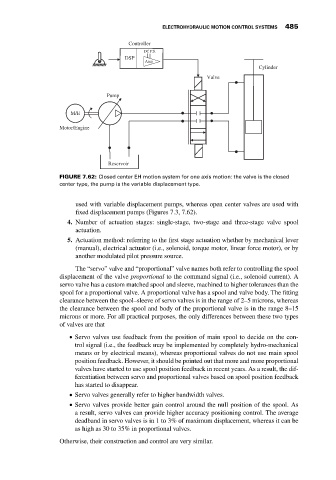Page 499 - Mechatronics with Experiments
P. 499
Printer: Yet to Come
October 9, 2014 8:41 254mm×178mm
JWST499-c07
JWST499-Cetinkunt
ELECTROHYDRAULIC MOTION CONTROL SYSTEMS 485
Controller
DC P.S.
DSP
Amp
Cylinder
Valve
Pump
M/E
Motor/Engine
Reservoir
FIGURE 7.62: Closed center EH motion system for one axis motion: the valve is the closed
center type, the pump is the variable displacement type.
used with variable displacement pumps, whereas open center valves are used with
fixed displacement pumps (Figures 7.3, 7.62).
4. Number of actuation stages: single-stage, two-stage and three-stage valve spool
actuation.
5. Actuation method: referring to the first stage actuation whether by mechanical lever
(manual), electrical actuator (i.e., solenoid, torque motor, linear force motor), or by
another modulated pilot pressure source.
The “servo” valve and “proportional” valve names both refer to controlling the spool
displacement of the valve proportional to the command signal (i.e., solenoid current). A
servo valve has a custom matched spool and sleeve, machined to higher tolerances than the
spool for a proportional valve. A proportional valve has a spool and valve body. The fitting
clearance between the spool–sleeve of servo valves is in the range of 2–5 microns, whereas
the clearance between the spool and body of the proportional valve is in the range 8–15
microns or more. For all practical purposes, the only differences between these two types
of valves are that
Servo valves use feedback from the position of main spool to decide on the con-
trol signal (i.e., the feedback may be implemented by completely hydro-mechanical
means or by electrical means), whereas proportional valves do not use main spool
position feedback. However, it should be pointed out that more and more proportional
valves have started to use spool position feedback in recent years. As a result, the dif-
ferentiation between servo and proportional valves based on spool position feedback
has started to disappear.
Servo valves generally refer to higher bandwidth valves.
Servo valves provide better gain control around the null position of the spool. As
a result, servo valves can provide higher accuracy positioning control. The average
deadband in servo valves is in 1 to 3% of maximum displacement, whereas it can be
as high as 30 to 35% in proportional valves.
Otherwise, their construction and control are very similar.

